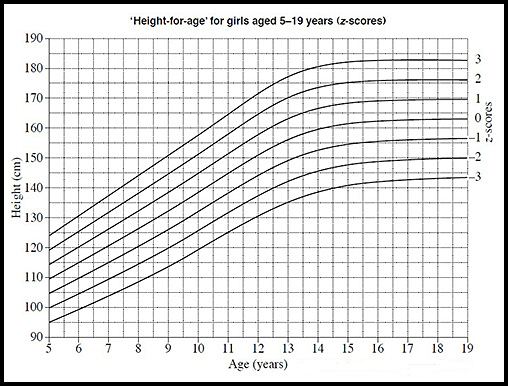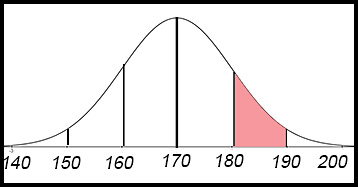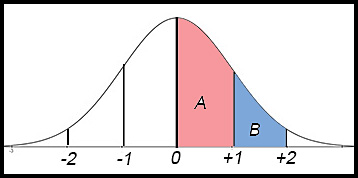Where the techniques of Maths
are explained in simple terms.
Statistics - the normal distribution .
Test Yourself 1 - Solutions.
- Algebra & Number
- Calculus
- Financial Maths
- Functions & Quadratics
- Geometry
- Measurement
- Networks & Graphs
- Probability & Statistics
- Trigonometry
- Maths & beyond
- Index
| The questions on this page are grouped in categories: |
| 1. Areas under the normal curve. |
| 2. |
| 3. Determining expected numbers of cases and percentages. |
| 4. Using only 1 tail. |
| 5. Using two tails. |
| 1. Area under the normal curve. | In a normal distribution, which three measures are all equal?
|
| 2. | |
| Determining expected numbers and percentages. | 12. A set of exam results from 25,000 students is assumed to be normally distributed.
How many students from this group are expected to score:
|
| 13. Luke completes a statistical analysis on the weights (in kilograms) of each member of his gym.
He finds that the data are normally distributed, with a mean of 55.0 and a standard deviation of 6.5. Answer.81.5% of members (34% + 47.5%). |
|
| The maximum daily temperatures during the summer months in Cummins Range, W. A. (where Rare Earth minerals are mined) are recorded.
These maximum temperatures are normally distributed with a mean of 21.4°C and a standard deviation of 7.6 °C.
|
|
| 14. The following graph indicates z-scores of ‘height-for-age’ for girls aged 5–19 years.
In each age, height is normally distributed.
Answer.(i) z = 1. (ii) Height =135 cm. (iii) 84% will be older (z = -1). (iv) An average (z = 0) 16 year old girl is about 162 cm. |
|
| 1 tail > | The heights of a group of friends are normally distributed with a mean of 160 cm and a standard deviation of 15 cm.
|
| 15. A normal distribution has a mean of 170 and a standard deviation of 10.
Answer.(i)Any value such that 1 ≤ z ≤ 2. (ii) % = 47.5% - 34% = 13.5%. |
|
19. A height of 169 cm is at a z score of 34% of students are between z = -1 and z = 0 and a further 50% have a z score > 0. Hence a total of 84% The expected number of students with a height in excess of 169 cm is 84% × 500 = 420. |
|
20. 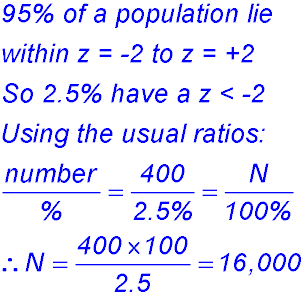 |
|
| 2 tail even
|
Heights of surf lifesavers are measured across a large number of clubs. The average height is 178 cm and the standard deviation was 7 cm.
The percentage of lifesavers between 164 cm and 192 cm was determined to be 88%. What conclusion can be made about the distribution of the heights of lifesavers? Answer.The heights are not normally distributed because we would expect 95% to be in the range+ 2 to -2 standard deviations. |
| 2 tail uneven | 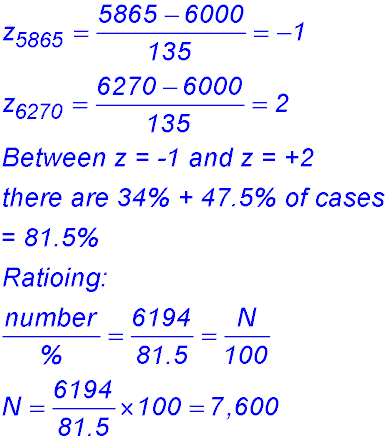 |
16. The lengths of 500 widgets manufactured at a particular factory are normally distributed with a mean of 10 cm and a standard deviation of 0.02 cm. The diagram below describes the distribution of the lengths of the components about the mean with the z-scores indicated.
Answer.(i) A z score of -1 means that the length of the component is 10 - 0.02 = 9.98 cm. (ii) A component in section A is between 10 and 10.02 cm say 10.01 cm. (iii) Number = 500 × (47.5%-34%) = 500×13.5% i.e. 68 components approx. |
|
| 17. The heights of 400 students are normally distributed. The mean height is 172 cm and the standard deviation is 3 cm.
Find the expected number of students with a height in excess of 169 cm. Answer.>169 = 34% + 50%.&there4:84%×400 = 336 students. |
|
| 1 tail < | A major seafood chain in NSW and Queensland analyses the hours worked by its staff across all locations. The analysis shows that the average hours worked per week across all permanent and casual staff was 20 hours with a standard deviation of 4 hours. Based on this information and assuming hours worked is normal is normally distributed, what percentage of staff worked less than 12 hours per week? |
|
|
| (i) 1 ≤ z ≤ 2. (ii) % = 47.5% - 34% = 13.5%. |
|
| Mixed questions | The normal distribution below represents the mass of 400 students. All measurements are in kilograms.
|
